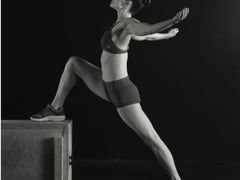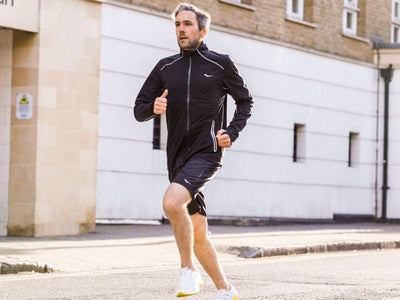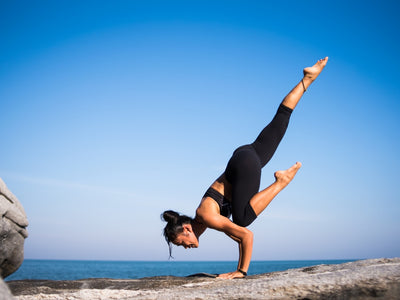6 Stretches to Improve Fascia Elasticity
Posted by Jim Applegate on

Improve your performance and prevent injury by focusing on these flexibility highways.
In fitness, muscles tend to get all the glory. Not surprising, considering we’re visual creatures, and besides, a well-defined hamstring tie-in looks darn good. But if you want to understand how to move more efficiently, prevent injuries and get stronger, you need to look beyond your glutes — and triceps and biceps and quads — and consider the admittedly less sexy, but equally important counterpart, the fascia.
Fascia 411
Fascia is often characterized as the connective tissue that encapsulates your muscles, but its actual function is far more complex.
“Fascia helps mitigate forces on certain parts of the body so there isn’t overuse of muscle tissue in one region and the degradation of tissue in another,” explains Chuck Wolf, MS, FAFS, director of Human Motion Associates in Orlando, Florida.
In other words, fascia serves to distribute force throughout the body by reducing it in one area and absorbing it in another, thereby enhancing mobility and preventing injury.
After studying the way fascial tissues worked together as the body moved in different planes of motion, Wolf devised the concept of the “flexibility highways.”
Each of these six highways is made up of a chain of tissues that work together to perform a particular type of movement, including flexion and extension, which occur in the sagittal plane; abduction and adduction, which occur in the frontal plane; and rotation, which occurs in the transverse plane.
However, in everyday life (as well as in the gym and on the field), human movement is not exclusive to one plane of motion. “If even if you’re moving in just one plane, those tissues are still being affected by the other two planes,” Wolf says. Therefore, in order to move efficiently, we have to keep all six highways in working order.
Highway Patrol
For the highways to work effectively, all fascial tissue needs to be elastic, resilient and strong enough to accommodate movement patterns in all directions. According to Wolf, fascia adapts when exposed to movements that cover all planes of motion and include both concentric (shortening) and eccentric (lengthening) contractions.
Training on machines doesn’t offer the necessary stimuli to create adaptations in the fascia, so you’re better off using weighted lunges than you are seated leg extensions.
For each flexibility highway, Wolf outlines a stretch progression designed to improve the elasticity and resilience of your fascia.
Incorporating these movements into your warm-up or cool-down can help prevent injury, correct movement inefficiencies and give you more power in your favorite athletic activity.
Hold each stretch for 60 seconds and repeat on both sides.

Anterior Flexibility Highway
This highway runs along the front of your body, from your feet up through your quads and abs), through your chest and anterior delts to your triceps and all the way up to your fingertips.
You engage this highway when you reach your arms overhead and slightly behind you, as when winding up for a medicine-ball slam or when catching a high basketball pass with both hands.
Wolf explains that people who sit a lot often have tightness in this highway, especially in the hip flexors and and abdominals, which therefore inhibits extension movements as well as walking and running.
Keep your left foot on the floor and step onto a knee-high bench or box with your right foot. Shift your weight forward over your right foot, keeping your left heel down and your left leg straight as you open your arms to the sides at shoulder height and actively pull them behind you to open your chest.
You should feel this stretch in your left calf, quad and hip flexor as well as through your core, chest and shoulders.

Posterior Flexibility Highway
This highway runs from the bottoms of your feet up through your calves and hamstrings, through your glutes and up your back and rear delts, over your skull and down to your forehead. This highway is engaged when you perform deadlifts or when you reach down to scoop up a baseball from the ground.
“When you have tightness here, it will be difficult for you to sit down or squat,” Wolf says. Even simple flexion movements like bending over to pick something up off the floor can be challenging, and lower-back pain can become an issue.
Stand with your left foot on the floor, toes rotated outward, and place your right heel on a bench or box, leg straight. Rotate your right toes to the right, then hinge forward from your hips over your right leg and hold.
You should feel the stretch along the back of your legs, the inner part of your hamstrings and through your back, shoulders and neck. Stand upright, turn your right toes to the left and your left toes inward and repeat. This shifts the emphasis toward your glutes and the outer part of your hamstrings.

Lateral Flexibility Highway
This highway runs up the side of your calf, over the outside of your thigh and hip, through your side body, across your triceps through your forearm.
You use this highway when you toss a ball up for a tennis serve or wind up to spike a volleyball. Tightness here inhibits rotation, which is critical to walking and running and can cause pain and dysfunction in your knees, lower back and shoulders.
Stand sideways to a rig or post and cross your right leg behind your left, feet flat on the floor. Hold the pole at shoulder height with your left hand, then stretch to the side and reach your right arm overhead to grasp the pole above your head.
Push your hips away from the pole while keeping your feet flat to stretch your entire side from your calf up through your thigh, glutes, hips, abdominals, back, shoulder and triceps. Repeat on both sides.

Anterior X-Factor Flexibility Highway
This highway runs diagonally from your foot and lower calf up your inner thigh, then across your body to your opposite-side obliques and chest, up through your shoulder and biceps to your forearm and hand.
When you reach back with one arm as you step forward with your opposite leg to throw a baseball or pull a golf club into a backswing, you’re tapping into this rotational pathway. Tightness here could result in issues like biceps or shoulder pain.
Position a knee-high box slightly in front of a rig leg or pole. Stand with your right foot flat on the floor, toes rotated outward, and place your left foot onto the box, toes straight.
Grip the rig with your left hand and shift your weight forward over your left foot, keeping your right leg straight and foot flat on the floor. Reach your right arm behind you and open your shoulder to the right to feel this stretch in your calf, inner thigh, hamstrings, abdominals, chest, shoulders and forearm.

Posterior X-Factor Flexibility Highway
This highway runs from your calf up through your hamstrings and glutes and then across to the other side of your body through your back, rear delts, triceps and forearm.
This pathway is used in movements like the follow-through on a tennis serve or a baseball throw. According to Wolf, athletes who have dysfunction in this highway often experience back pain.
Stand sideways to a rig leg or pole and hold the back side of the pole with your left hand. Reach across in front of your chest to grasp the rig with your right hand, then bend your left knee and place your left ankle on top of your right thigh.
Sit back with your hips and bend your right knee until you feel a stretch in your calf, hamstrings, glutes, hips, back, shoulders, triceps and forearms.

Turnpike Flexibility Highway
This is the trickiest highway to visualize as it wraps completely around your body in a corkscrew pattern.
“Start at the left side of the back of your neck, then draw a diagonal line toward the right scapula and then around under your right armpit, down through your chest and abdominal complex and around to your left hip,” Wolf says.
Tightness in this highway could impair a wide receiver’s ability to turning back to look for the pass as he is running downfield or a jogger checking behind her for traffic before crossing the street.
Face a rig or a pole and stand with your feet staggered and your left foot forward, toes pointing toward the pole. Reach across your body with your left hand and grab hold of the right side of the pole at shoulder height.
Reach your right arm under your left and rotate your torso to the left and hold. Next, reach your right arm behind you and rotate your torso to the right, opening your chest. You should feel both stretches in the shoulders, upper back and neck.
Written by Jenessa Connor for Oxygen Magazine and legally licensed through the Matcha publisher network. Please direct all licensing questions to legal@getmatcha.com.








